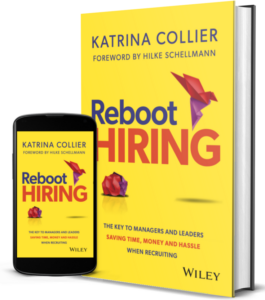Talent Acquisition… what do they do again?
It is optimistic to see so many new job notifications for talent acquisition professionals in my feed. It reminds me of when they started appearing after the over-firing, oops, I mean over-downsizing in 2020.
But then I thought about mid-2022 when the layoffs began from the over-hiring and lasted throughout 2023, and I felt less optimistic. How secure are your new roles? Will TA pros again be amongst the first to be ‘let go’ (awful expression) because they only think you recruit, so they don’t see that you could be redeployed internally in a hiring freeze?
And then what about all the HR tech vendors peddling the age-old talent acquisition is replaceable by AI nonsense? Just because I see it’s baloney – hence, I wrote The Robot-Proof Recruiter – sadly, it doesn’t mean your leaders will. I see many giving it a try in the near future; God help candidates! 🫣
I keep coming back to this issue: Talent Acquisition has a perception problem. Compared to other functions, it is new. It has only been in its current form for around a decade. Many employees confuse it with HR or think you only recruit.
The perception problem starts at the beginning of the hiring process.
The first meeting with your manager or leader.
Side note about the meeting’s name: thank you to everyone who answered my poll and commented about the name of this meeting. We definitely want to stop calling it an ‘intake’ as it does sound like a pizza order or a ‘job brief’, which sounds unimportant and avoidable. Yes, I know I called it an Intake Strategy Session in Chapter 5, but I now really love Recruitment Alignment Meeting because it’s about aligning on so many things, including how TA is perceived.
Change the perception of Talent Acquisition
Ok, there are lots of ways this could happen, but here are a few I think should be non-negotiables in 2024. Easy things to do every single day to change minds.
1. No meeting = no working on the role. No exceptions.
This applies to external as well, but an uniwillingness by a manager to participate in a recruitment alignment meeting should equal no working on the role. Regular readers have heard this before – in the meeting, you gain better information, commitments to process, agreed SLAs, less time wasted, better candidate experience, etc – but now I want to add, make sure you tell them what you do. Don’t gloss over what you will be doing in this hiring process!
Without a meeting or in a half-arsed rushed one, how can you change their perception of what you do? In a proper meeting, you can explain exactly what it is you will do to fill the role. They think you advertise, CVs fall down from the sky, and you book interviews. Is that all you do? No! So tell them. Surprise them. Show off your expertise. Knock their socks off.
⛔️ If your TA leader insists that you work on roles when you cannot get managers to participate in the meeting properly, you have to be concerned about the perception of TA within your company. To me, it’s a massive 🚩! 💨
2. Show them what talent acquisition does
Make sure they know about your cross-transferable sourcing skills. Imagine how sales or marketing could benefit from those super sleuthing skills or the talent mapping you could get up to in a lull. For leaders, where else in the business could your strategy or data skills be utilised?
What about your superhuman skills of trust, empathy, influence and curiosity, which you use to woo and convert candidates to employees? Could you teach them to junior employees in other areas? I am now thinking out loud… but it’s worth making sure leaders know your skills.
3. Ask tougher questions
Nothing gains respect faster than making someone think. Go into the recruitment alignment meeting (ooh, I do like that) ready to (re)align their expectations with market reality. Ask them a big open question they don’t expect, and watch them continue talking past the few minutes they were going to grant you.
Regular readers know my fave, ‘How will you know at the end of 12 months you’ve hired the right person?’ and there are more in Chapter 5. I also want you to know the cost of that role remaining open, which could be an actual figure, the loss of team members, a missed project deadline, a lost client, a missed bonus and so on.
🎓 For a superb course that is jam-packed with questions (quite several surprising me with my 20+ years of experience!!), check out this new training from Mitch Sullivan: Taking The Job Brief. It is way more than a pile of questions – lots of videos, tips, guides, and quizzes, and will pay for itself easily. 🎓
And use Elizabeth Lembke’s question, ‘If there is a 20% downturn will this role remain or be made redundant?’ 💥 Boom!! 💥 Because how many CEOs who overhired have been ‘let go’? If they and the workforce planners can’t protect your people, you can try to by asking this question. Plus, people could be apprehensive about moving after the BS of the last nearly 4 years, so it’s good to know.
Possibly the biggest lesson from 2021/22 should be that just because the role is approved doesn’t mean we should be hiring for it… question, question, question. Show your business acumen, tenacity, confidence and value to the company.
How else could you change the perception of talent acquisition with your managers and leaders?


